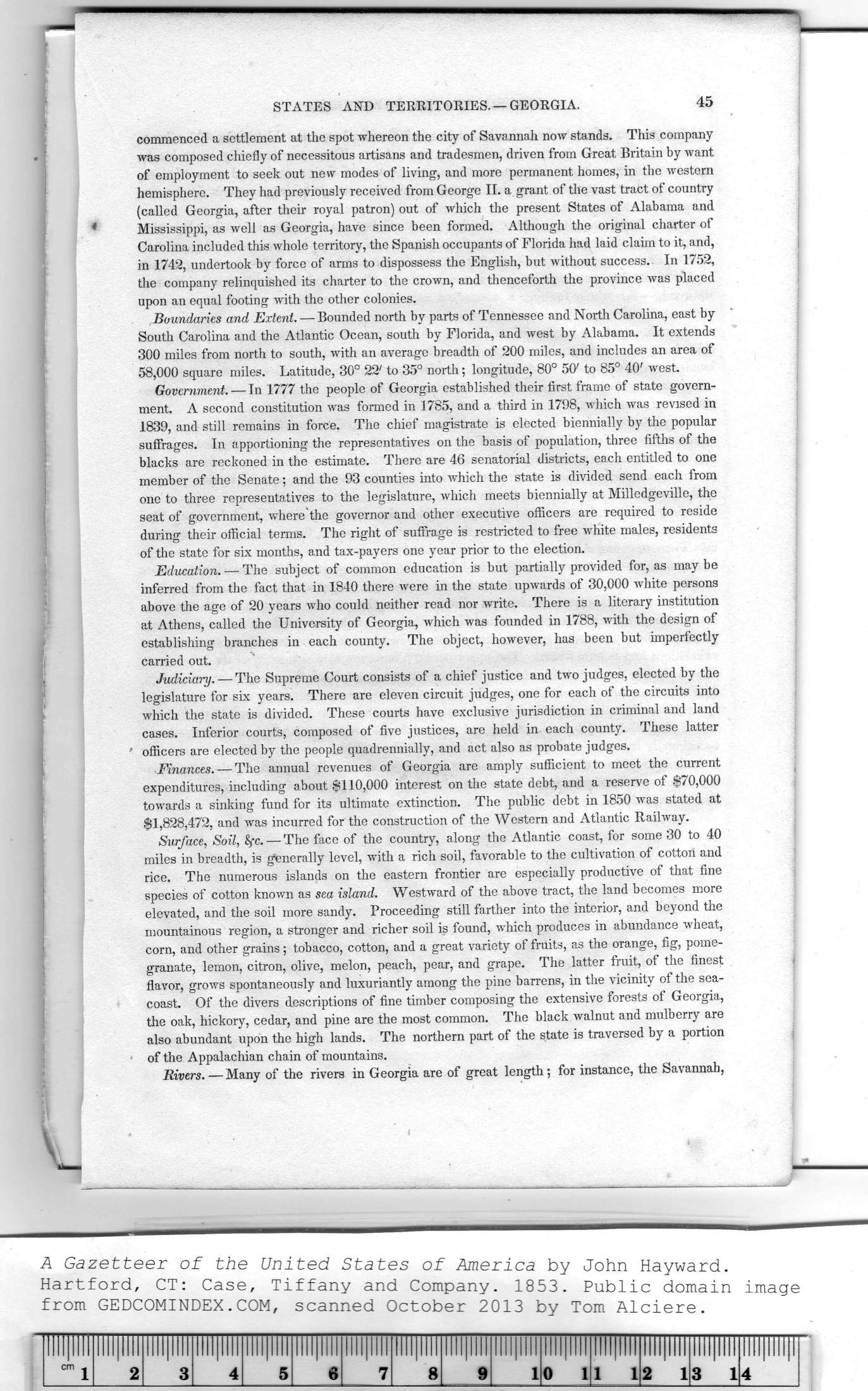|
|
Note: Ctrl and + increases the font size of the text below, Ctrl and - decreases it, and Ctrl and 0 resets it to default size.
STATES AND TERRITORIES. — GEORGIA. 45
commenced a settlement at the spot whereon the city of Savannah now stands. This company
was composed chiefly of necessitous artisans and tradesmen, driven from Great Britain by want
of employment to seek out new modes of living, and more permanent homes, in the western
hemisphere. They had previously received from George II. a grant of the vast tract of country
(called Georgia, after their royal patron) out of which the present States of Alabama and
Mississippi, as well as Georgia, have since been formed. Although the original charter of
Carolina included this whole territory, the Spanish occupants of Florida had laid claim to it, and,
in 1742, undertook by force of arms to dispossess the English, but without success. In 1752,
the company relinquished its charter to the crown, and thenceforth the province was placed
upon an equal footing with the other colonies.
Boundaries and Extent. — Bounded north by parts of Tennessee and North Carolina, east by
South Carolina and the Atlantic Ocean, south by Florida, and west by Alabama. It extends
300 miles from north to south, with an average breadth of 200 miles, and includes an area of
58,000 square miles. Latitude, 30° 22' to 35° north; longitude, 80° 507 to 85° 40' west.
Government. — In 1777 the people of Georgia established their first frame of state govern-
ment. A second constitution was formed in 1785, and a third in 1798, which was revised in
1839, and still remains in force. The chief magistrate is elected biennially by the popular
suffrages. In apportioning the representatives on the basis of population, three fifths of the
blacks are reckoned in the estimate. There are 46 senatorial districts, each entitled to one
member of the Senate; and the 93 counties into which the state is divided send each from
one to three representatives to the legislature, which meets biennially at Milledgeville, the
seat of government, where the governor and other executive officers are required to reside
during their official terms. The right of suffrage is restricted to free white males, residents
of the state for six months, and tax-payers one year prior to the election.
Education. — The subject of common education is but partially provided for, as may be
inferred from the fact that in 1840 there were in the state upwards of 30,000 white persons
above the age of 20 years who could neither read nor write. There is a literary institution
at Athens, called the University of Georgia, which was founded in 1788, with the design of
establishing branches in each county. The object, however, has been but imperfectly
carried out.
Judiciary. — The Supreme Court consists of a chief justice and two judges, elected by the
legislature for six years. There are eleven circuit judges, one for each of the circuits into
which the state is divided. These courts have exclusive jurisdiction in criminal and land
cases. Inferior courts, composed of five justices, are held in each county. These latter
officers are elected by the people quadrennially, and act also as probate judges.
Finances. — The annual revenues of Georgia are amply sufficient to meet the current
expenditures, including about $110,000 interest on the state debt, and a reserve of $70,000
towards a sinking fund for its ultimate extinction. The public debt in 1850 was stated at
$1,828,472, and was incurred for the construction of the Western and Atlantic Railway.
Surface, Soil, fyc. — The face of the country, along the Atlantic coast, for some 30 to 40
miles in breadth, is generally level, with a rich soil, favorable to the cultivation of cotton and
rice. The numerous islands on the eastern frontier are especially productive of that fine
species of cotton known as sea island. Westward of the above tract, the land becomes more
elevated, and the soil more sandy. Proceeding still farther into the interior, and beyond the
mountainous region, a stronger and richer soil is found, which produces in abundance wheat,
corn, and other grains; tobacco, cotton, and a great variety of fruits, as the orange, fig, pome-
granate, lemon, citron, olive, melon, peach, pear, and grape. The latter fruit, of the finest
flavor, grows spontaneously and luxuriantly among the pine barrens, in the vicinity of the sea-
coast. Of the divers descriptions of fine timber composing the extensive forests of Georgia,
the oak, hickory, cedar, and pine are the most common. The black walnut and mulberry are
also abundant upon the high lands. The northern part of the state is traversed by a portion
of the Appalachian chain of mountains.
Rivers. — Many of the rivers in Georgia are of great length; for instance, the Savannah,
A Gazetteer of the United States of America by John Hayward.
Hartford, CT: Case, Tiffany and Company. 1853. Public domain
|
